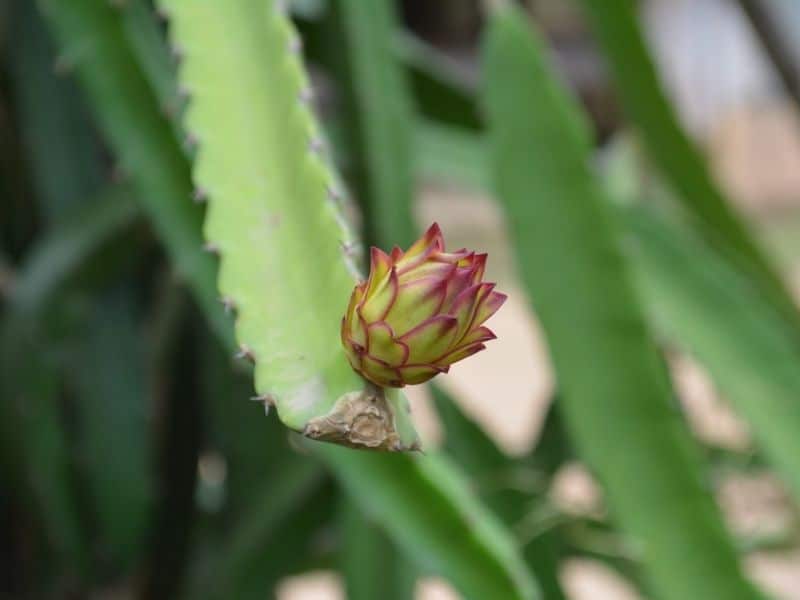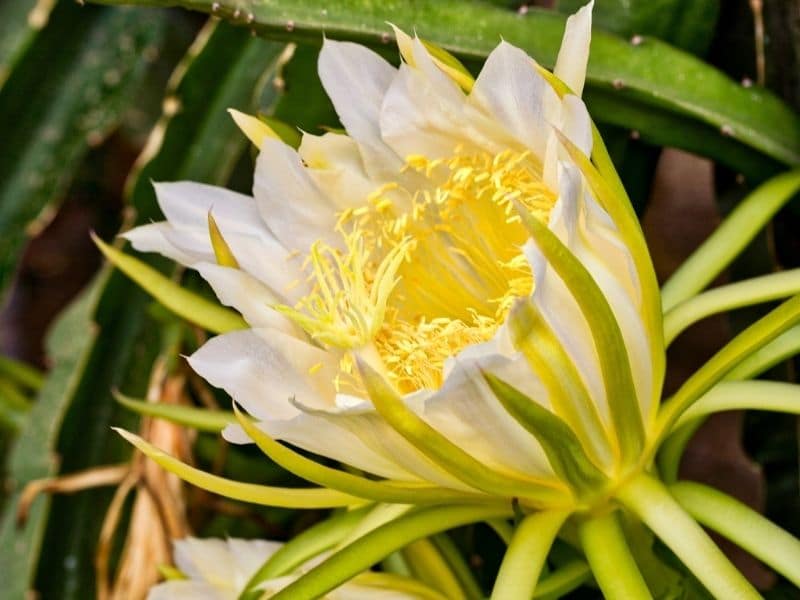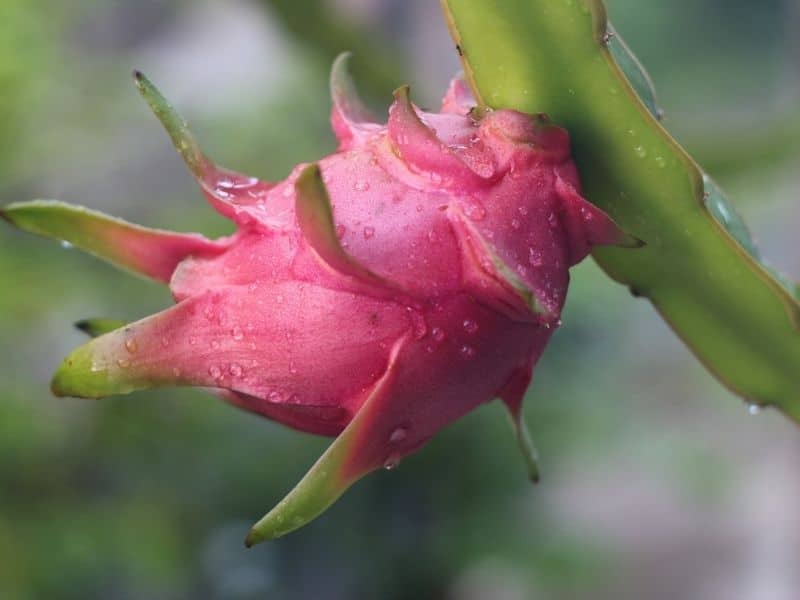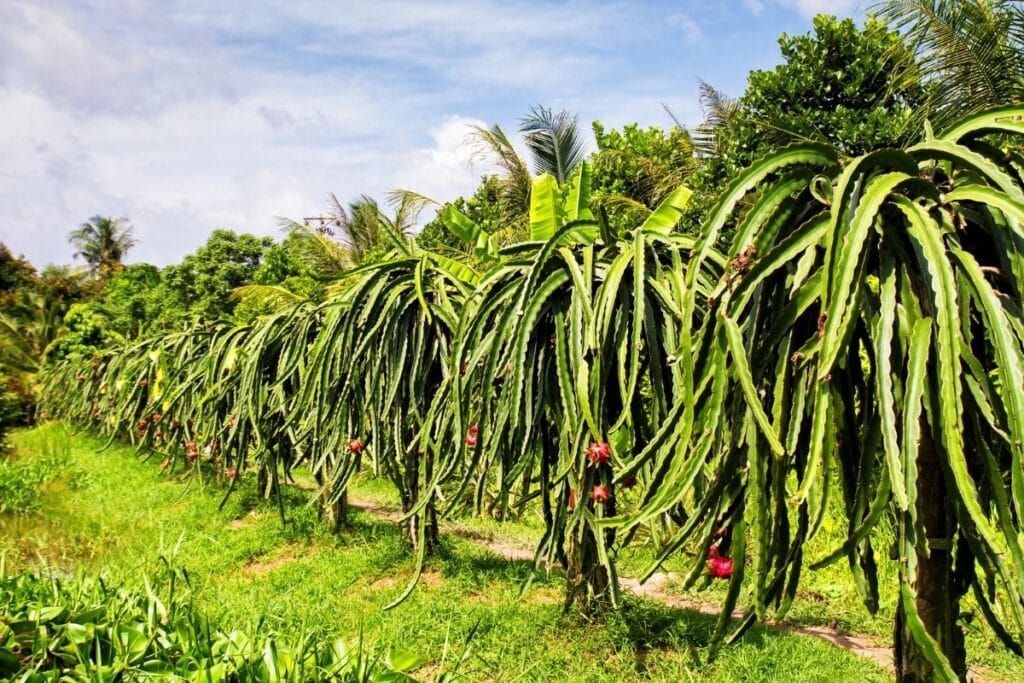The spiky appearance of cacti makes them appear as dangerous plants. In fact, this is one of their defense mechanisms—to drive away most animals that will attempt to consume them.
But because people are adventurous, and we have a need to survive, the cacti group is explored for their digestible properties.
Several cacti species actually offer edible parts which are used in many delectable dishes today, the most popular one being the Dragon Fruit cactus.
This cactus not only provides food but ornamental and functional purposes in the landscape too. If you are looking for a plant to add to your edible landscape or your cacti collection at home, this special cactus is for you.
What is a Dragon Fruit Cactus?

The Dragon Fruit cactus may sound mythical, but it actually exists and originated from Central America and northern South America. It is scientifically called Hylocereus undatus and is one of the few cacti that are both epiphytic and terrestrial (1).
The plant got its common name from the scaly appearance of the pink, red, peach, sometimes yellow fruit that can weigh up to 2 pounds (0.9 kg).
The edible fruit makes this cactus popular around the world, and it goes by other names such as pitaya, night-blooming cereus, belle of the night, selenicereus undatus, the white-fleshed pitahaya, etc…
This cactus species has 3-sided succulent jointed stems with small spikes running down the edges and fibrous aerial roots that allow the plant to cling to surfaces (2).
Despite the sprawling habit, each plant can reach an impressive height of 30 feet (9.1 m) with the support of trees, shrubs, and rocks in the wild.

Hylocereus undatus is considered the showiest cactus because, in summer, it produces 12 in (30 cm) fragrant flowers with white petals, large yellow stigma, and many stamens. The massive flower is night-blooming and lasts only from dusk until dawn but once pollinated, it turns into a 4 to 6 in (10 to 15 cm) exotic scaly fruit with thick white pulp inside full of tiny black seeds (3).
How to Grow Dragon Fruit Cactus

Soil
Dragon fruit cacti are not fussy about soil type, but well draining potting mix is paramount. Soggy roots are a recipe for disaster. A cactus or succulent potting mix works well, or you can amend the soil with perlite, peat moss, or coarse sand to improve drainage.
Water
While cacti are known for their drought tolerance, dragon fruit enjoys consistent moisture, especially during its active growing season.
Water dragon fruit cactus sparingly, allowing the soil to dry out slightly between waterings. During the growing season (spring and summer), water them when the top inch of soil feels dry.
Reduce watering frequency in the fall and winter when growth slows down. Overwatering can cause the roots to rot, so striking a balance and avoiding waterlogged conditions is essential.
Sunlight
While dragon fruit plants thrive in warm weather and full sunlight, intense sun in hot, dry regions can damage their stems.
Place your tropical cactus in a location where they can receive at least six hours of direct sunlight daily, such as a south-facing window or outdoors in a sunny spot. Rotate the plants regularly to ensure even exposure to sunlight and promote balanced growth.
Like most indoor plants, if your area frequently reaches nearly 100°F, choose a spot with partial shade.
Pests and Diseases
Dragon Fruit cacti are susceptible to pests common to all fleshy plants. Sucking insects like mealybugs, aphids, and scales are often seen on the stems and fruits of those grown indoors.
These climbing cactus should be treated with mild soap solutions or diluted alcohol as soon as the pests are observed.
Plants grown for food, especially on a large scale, are prone to thrips. An environmental approach to managing these by most farmers is through the use of the pest’s natural enemies like ladybugs and lacewing larvae. These insects are more beneficial than harmful and have been used as biocontrol agents in agriculture (4).
Propagation and Maintenance
Propagating a Belle of the Night plant is the same as propagating most branching cacti, through seeds and cuttings. Stem cuttings are preferred over seeds because they don’t take long to produce an established, rooted plant, and they also possess the characteristics of the mother plant (5).
Cuttings are collected from the branching stems, usually 4 to 8 in (10 to 20 cm) in length.
After allowing the cuttings to heal in 1 to 2 days, they are planted in a potting mixture of 1 part dry cow dung, 1 part compost, and 2 parts sand. Placing the newly potted plants under shade will allow them to root fast.
It can take several months to a year for a cutting obtained from a mature plant to start fruiting. While the dragon fruit plants grow, stakes must be installed to help train the growth of the plant.
A Dragon Fruit tree tends to be heavy because of the stems and the fruits, so a common practice among growers is tying immature stems to a wooden or concrete column so that the growing aerial roots will eventually anchor on the support.
A complete fertilizer is also recommended during the early stage of the plant’s growth, usually before they start flowering. For pitayas grown farmed for fruits, fertilizers low in nitrogen and high in potassium are recommended to promote fruit development (5).
Edible and Landscape Uses

The Dragon Fruit may have originated in the Americas, but they are now widely commercialized throughout Asia and Europe where the climates are accommodating.
The majority of its cultivation is for the production of decorative and edible fruit. The flesh can be eaten raw or turned into liqueur and even ice cream. The dried flowers are also eaten as vegetables in places like Taiwan (Herbaria).
As an ornamental plant, the Hylocereus undatus is an extremely unruly plant that may or may not appeal to houseplant growers. But they make excellent hedges or foundation plants in the American landscape, serving as a protective barrier with character (6).
The plant is also commonly used as rootstock when grafting other cacti. The popular “moon cactus” is a combination of Hylocereus and Gymnocalycium.
FAQs
How do I take care of a dragon fruit cactus?
To care for a dragon fruit cactus, provide well draining soil, water sparingly, and ensure proper drainage to prevent root rot. Support the cactus as it grows, and fertilize lightly during the growing season.
How much sun does a dragon fruit cactus need?
Dragon fruit cacti thrive in full sun, requiring at least 6 hours of sunlight daily for optimal growth and fruit production.
Can I grow dragon fruit indoors?
While it’s possible to grow your own dragon fruit plant indoors, it requires a large container, ample sunlight, and possibly supplemental lighting to mimic outdoor conditions. Ensure proper ventilation and pollination for indoor cultivation.
Are dragon fruit cactus hard to grow?
Yes, Dragon fruit cacti can be challenging to grow due to their specific soil, water, and sunlight requirements, as well as susceptibility to pests and diseases. However, with proper care and attention, they can flourish and produce delicious fruit.
Is dragon fruit actually a cactus?
Yes, dragon fruit (Hylocereus spp.) is indeed a type of cactus. It belongs to the family Cactaceae and is native to Central and South America.
References
Reference List:
(1) Wyman, D. Wymans’s Gardening Encyclopedia. Simon and Schuster. 1986. P. 1221.
(2) Bagnasco, J. & Redmuiller, B. Jr. Succulents: Choosing, Growing, and Caring for Cactuses and other Succulents. Cool Springs Press. 2019. P. 208.
(3) Friend, L. Hylocereus undatus (Haw.) Britton & Rose (Cactaceae). Department of Plant Science, University of Oxford. 2002 (online) https://herbaria.plants.ox.ac.uk/bol/plants400/Profiles/GH/Hylocereus.
(4) Carillo, D., et al. Pitaya (Dragon Fruit) (Hylocereus undatus) Pests and Beneficial Insects. University of Florida. 2019. (online) https://trec.ifas.ufl.edu/media/trecifasufledu/public-notices/Pitaya-EDIS.pdf.
(5) Sri Lanka Department of Agriculture. Dragon Fruit-Hylocereus undatus. Fruit Crops Research and Development Centre. (online) https://www.doa.gov.lk/FCRDC/index.php/en/2015-09-22-05-59-43/54-sd.
(6) Lawrence, E. Beautiful at All Seasons: Southern Gardening and Beyond. Duke University Press. 2007. P. 238.
(7) Rojas-Sandoval, J. Hylocereus undatus (dragon fruit). Smithsonian Institution National Museum of Natural History. 2016. (online) https://www.cabi.org/isc/datasheet/27317.
Close
*photo by kefirm/depositphotos







